Review of the Crucial P5 Plus PCIe Gen 4 NVMe SSD
It seems like EVERY brand seemingly has its own PCIe4 NVMe SSD to release in 2021. If you are a already established data storage media provider or are already an established name in PC components, then that almost certainly means that you either already have or are planning on releasing your own storage. The latest company to introduce a PCIe 4.0 M.2 NVMe SSD is Crucial with their P5 Plus series. Already a big name in memory modules and extending their existing range of Solid State Drives, the Crucial P5 Plus is an unusual competitor to the current growing pack of 7,000MB/s solutions, in that it arrives with a lower 6,600MB/s reported maximum, but with much higher endurance and an in-house designed architecture. For those that aren’t aware, Crucial and Micron are effectively one and the same, which means that this SSD arrives from the same house that makes a large proportion of the NAND used in their competitor’s hardware, so I have high hopes for how well this device performs, as although they are the first to vouch that their top speed is a pinch lesser than some, they get quite close and do so at a better price point than most. Additionally, the Crucial P5 Plus arrives amidst a deluge of other PCIe4 M.2 NVMe SSDs from the likes of Seagate, MSI, Gigabyte and more, so we need to see what this new SSD brings to the table as it’s USP. So, let’s take a look and see if the Critical P5 Plus NVMe SSD is a mature storage choice or a little late to the party? Let’s go.
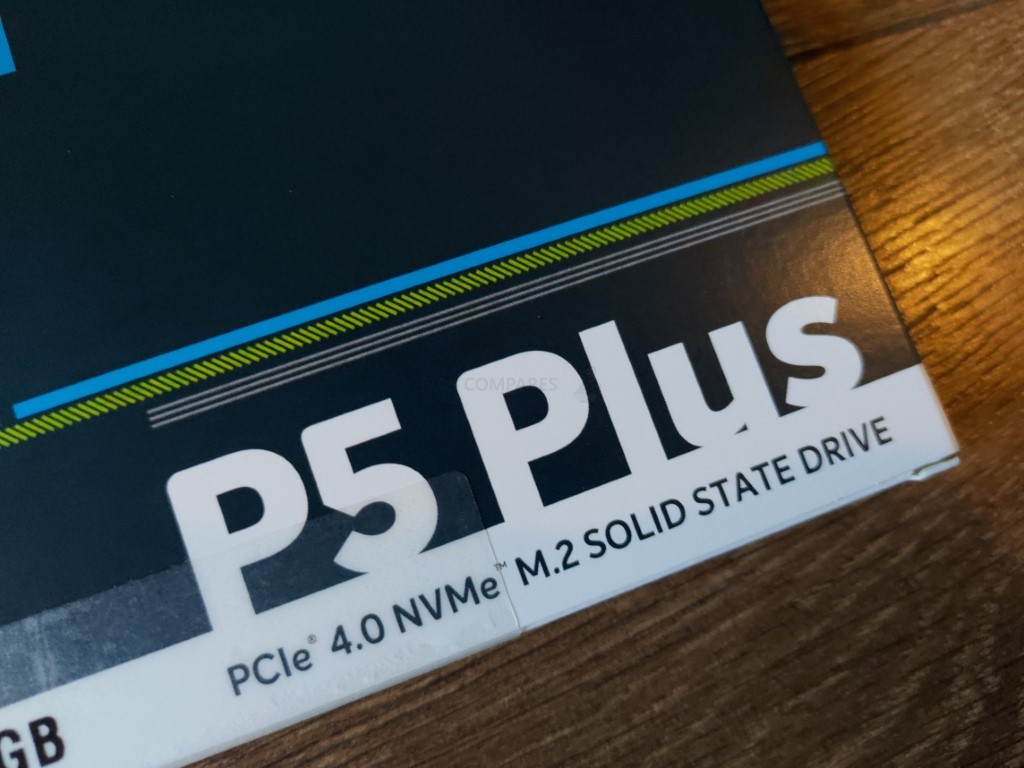
Crucial P5 Plus SSD Review – Quick Conclusion
The Crucial P5 Plus is an SSD that has arrived into the market alongside a bunch of other PCIe 4.0 NVMe SSDs, but does it via another door. Much like how the Seagate Firecuda 530 arrived with a primary focus on Durability and Endurance for their drive, the Crucial P5 Plus arrives with some of the most mature and affordable architecture available in this new wave of storage. Rather than target the obvious and potentially un-relatable high sequential read/write audience, that may find out shortly afterwards that this isn’t typical of day-to-day use, Crucial have produced a much more multi-purpose drive that wants to appeal to more users. It would be foolish to ignore that the price point of the P5+ is not one of its most appealing factors for some, but this is further improved by the fact that this is an almost exclusively in-house drive, which is increasingly rare right now. Where the Critical P5 Plus SSD falters is when you make direct comparisons against other PCIe4 drives on sustained big-data performance and when you look more closely at its power efficiency. If you are considering the Crucial P5 for your PC or PS5 gaming storage setup, there are better drives out there right now. But for general use, caching of smaller data, as well as for business buyers looking for a good balance of performance vs reliability vs price, this is likely your best choice for this evolving SSD type.
Crucial P5 Plus SSD Review – Packaging
Crucial are pretty famous for having fantastically practical retail packaging and the P5 Plus conforms heavily to this legacy! Given they are a brand that is known by their name as one of the premier PC component suppliers for homes and businesses alike, they do not really need to make a splash with fancy graphics, PC Game affiliation or aggressive design. They are a functional brand with a functional product and this box ticks all those boxes. Dull but safe!
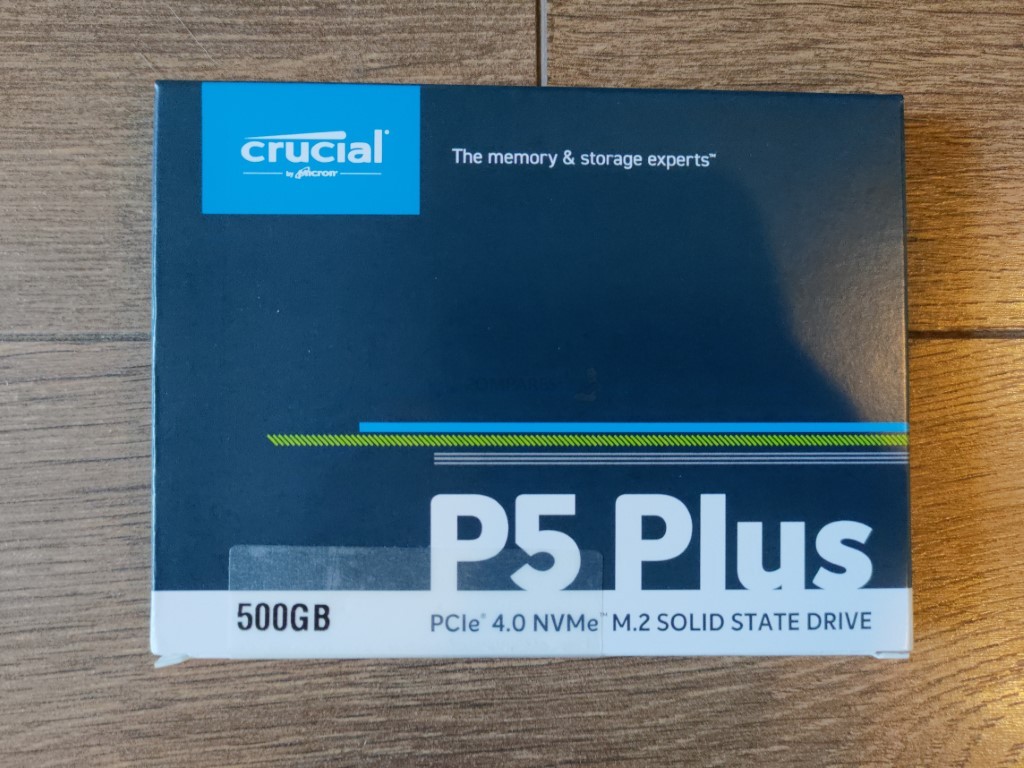
The drive has more information on the rear that details a lot of the specifics and even in these blobs of info, the focus on a slightly more PC savvy audience is clear.
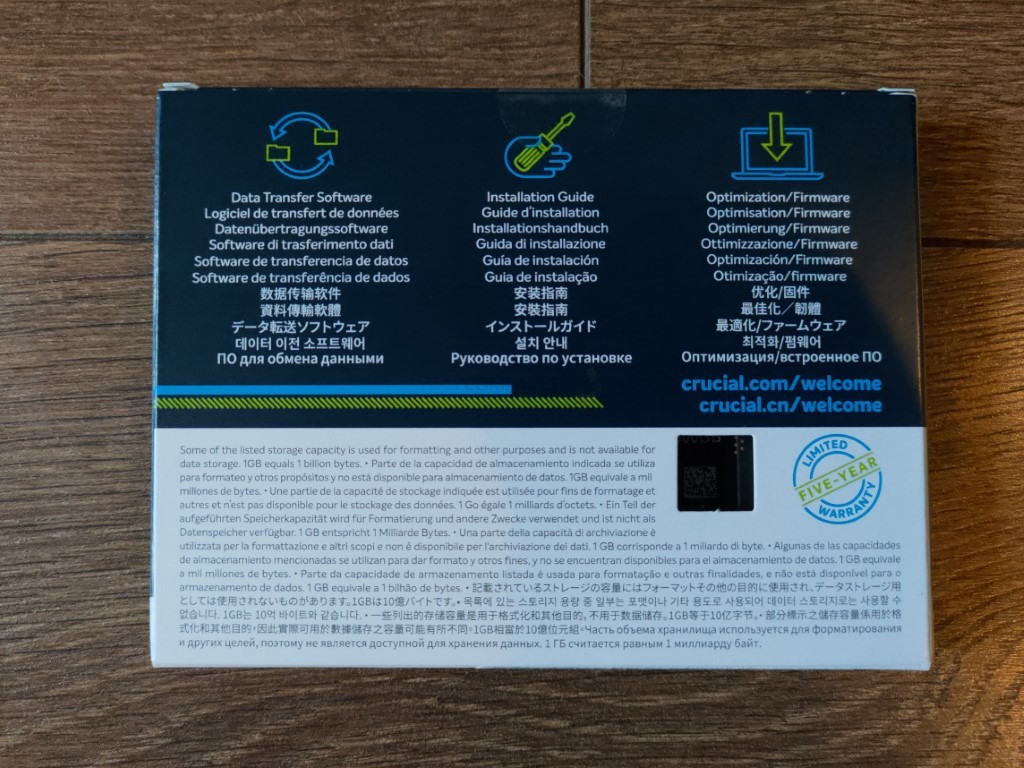
The contents of the retail box are quite standard, with the Crucial P5 Plus arriving in a plastic protective shell and an inclusive setup guide. All fairly standard stuff, but I did like the large compartment in the shell for the m.2 board screw. Wild overkill but it’s genuinely surprising how many brands do NOT include this screw with an M.2 SSD.
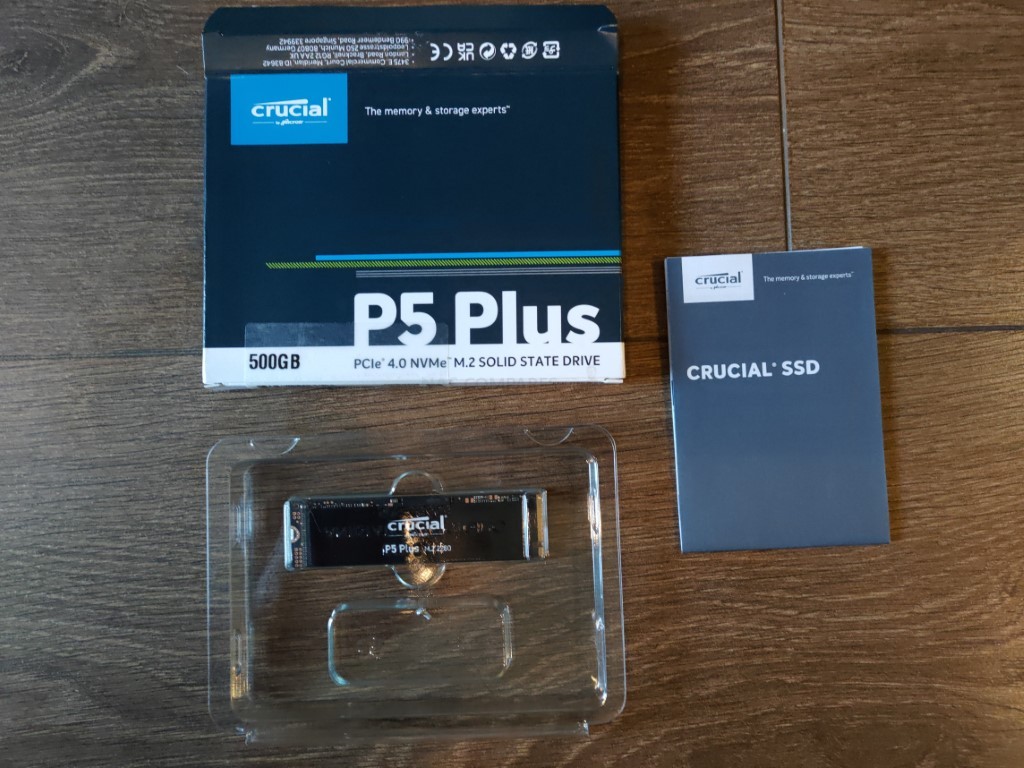
Removing all retail packaging, we have the crucial P5 Plus drive on its own. Even when factoring in that the SSD for this review is a 500GB model, it is a remarkably understated drive. The top of the drive has a simple black label covering the bulk of the major chips on the PCB. It is quite surprising that the P5+ does not feature any heatsink, inclusive or optional extra, something that most brands at least factor as an option. This is especially surprising, given that in testing the Crucial P5 Plus ran quite hot. Day 1, big heatsink is certainly recommended!
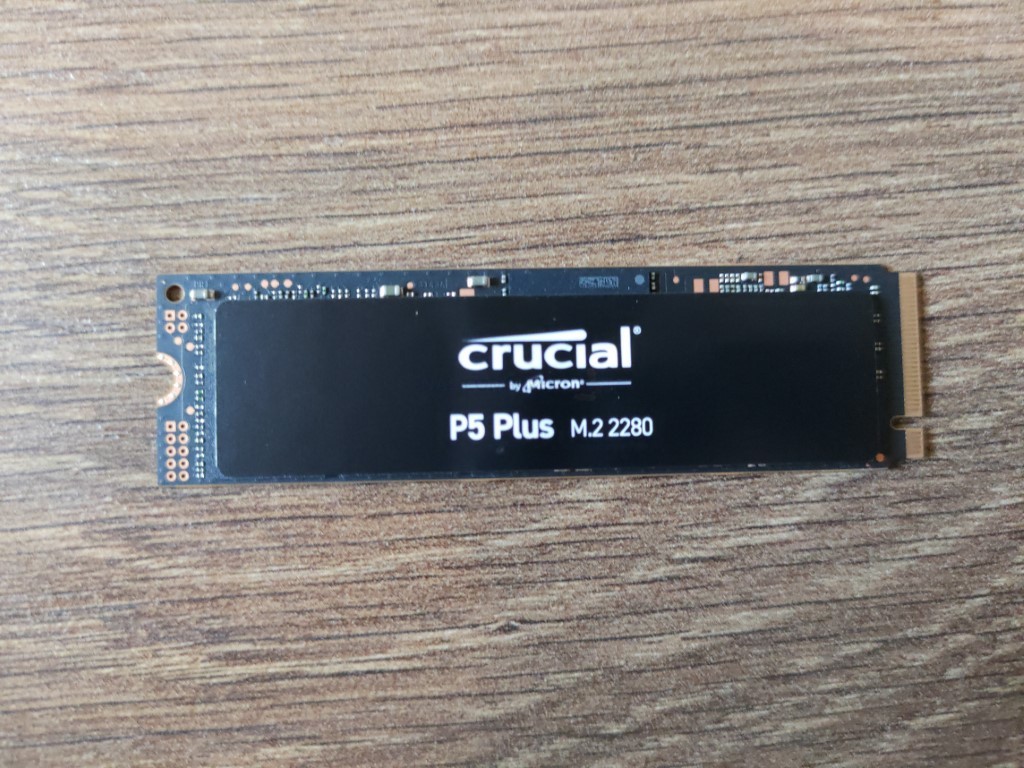
The black retail sticker is not any kind of metal/thermal plate (as found in the likes of the Sabrent Rocket series) and does not feature any anti-removal/voided-warranty provisions in place.
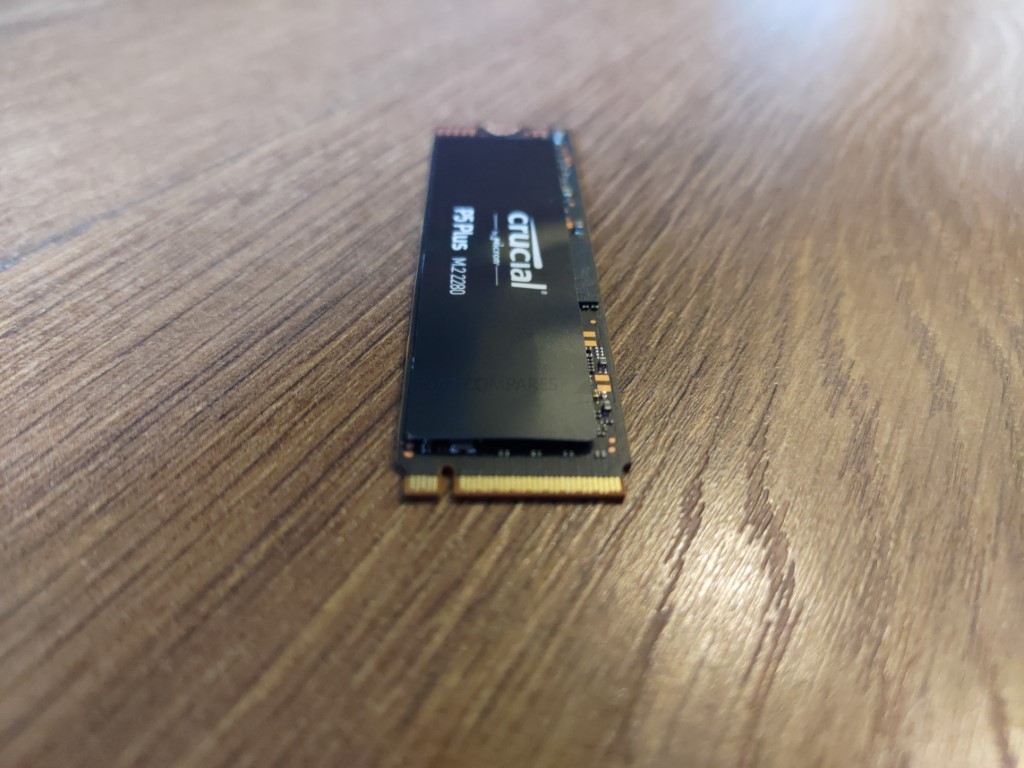
A quick look at the rear of the drive (the 500GB is single-sided) shows us some more information on the SSD part numbers, serial, etc. All fairly standard, if unexciting stuff. You definitely get the feeling of ‘functionality’ in the Crucial P5 Plus.
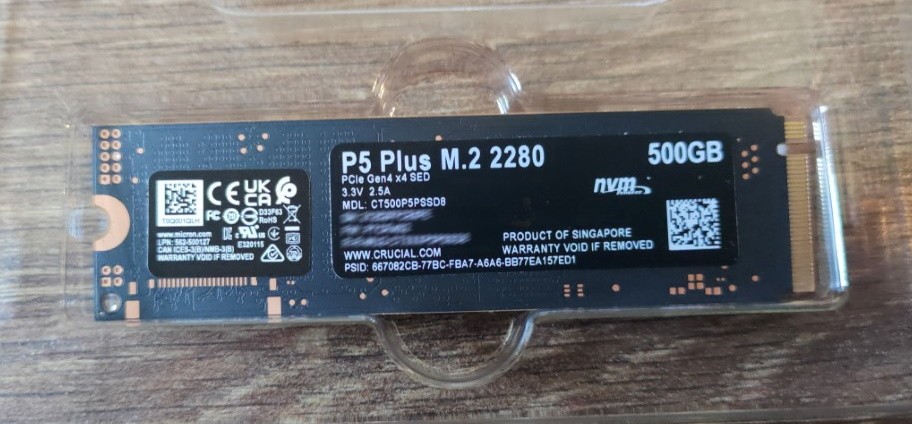
So that is the physical design of the Crucial P5 Plus SSD. But what about the hardware components themselves? Does the Crucial P5 Plus cut the mustard in terms of current generation hardware and protocols? Let’s find out.
Crucial P5 Plus SSD Review – Hardware Specifications
As you might expect from an M.2 NVMe SSD that boldly promises performance of over 7,000MB/s sequential read (ie BIG data), the hardware specifications and architecture of the Crucial P5 Plus are quite modern. Indeed, for all the big talk of the Seagate Firecuda 530 hardware (still currently the ‘score to beat’ PCIE Gen4 m.2 NVMe right now) being top tier, the Crucial P5 Plus is pretty darn similar on the spec sheet! Below is how it looks:
| CRUCIAL P5 PLUS
250GB – $64.99, 500GB – $104.99, 1TB – $179.99, 2TB – $364.99 |
|
| PCIe Generation | PCIe Gen 4 |
| NVMe Rev | NVMe 1.4 |
| NAND | 3D TLC Micron 176L |
| Max Capacity | 2TB – Single Sided |
| Controller | Crucial NVMe Arch. |
| Warranty | 5yr |
I know a lot of the above will seem needlessly technical, so below we can bring the most important considerations into sharper focus.
Hardware Focus of the Crucial P5 Plus SSD Series
As mentioned, the Crucial P5 Plus arrives with an in-house developed controller, which should not come as a surprise when you know that Micron is so heavily involved with this SSD production. The controller’s exact architecture is not hugely shared, but its support of LPDDR4 memory over 8 channels, but whether this is a 4-core processor or a heftier one like the one in the non-plus revision of this SSD is unconfirmed. This controller still does a top rate job of managing the drive and power usage and thanks to the premium quality NAND that this drive arrives with, it has good endurance when compared against competitor drives, such as the Samsung 980 Pro and WD Black SN850, though falls short of the Firecuda 530’s 0.7 DWPD, despite it featuring near-identical NAND from Micron too.
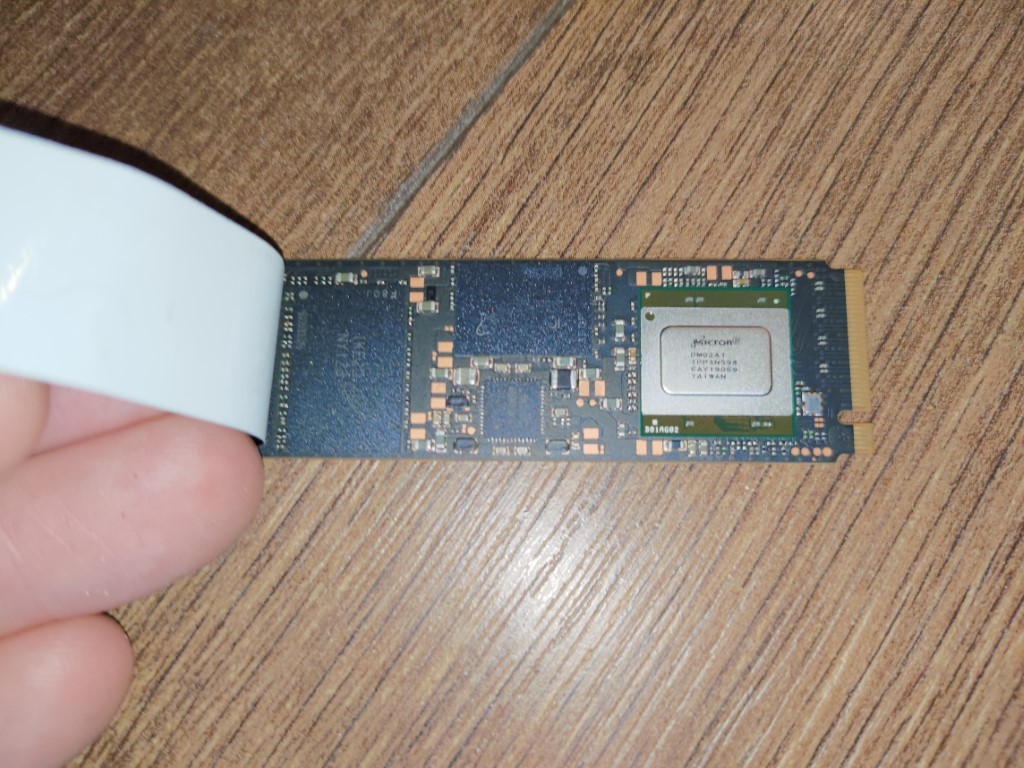
The NAND on the Crucial P5 Plus is one of the highlights of this drive over its competitors, arriving with 176L 3D TLC NAND. This is particularly noteworthy, as most other PCIe 4.0 M.2 NVMe SSD arrive with 96 Layer Micron or Kioxia NAND and that additional layering with improving a number of key performance elements in this drive’s lifespan. For all that NAND quality though, you cannot help but get the impression that the in-house controller on this SSD is not able to fully take advantage of this NAND in efforts to cross into the 7,000MB/s Seq Read mark and in comparison to the Phison E18, is a little left behind. That said, the Crucial P5 Plus is noticeably lower in price than pretty much all of the PCIe Gen 4.0 NVMe SSDs out there right now, even those released at the end of 2020 (WD Black SN850 & Samsung 980 Pro) and therefore if you stack value vs value, the Crucial P5 Plus may well come out the victor.
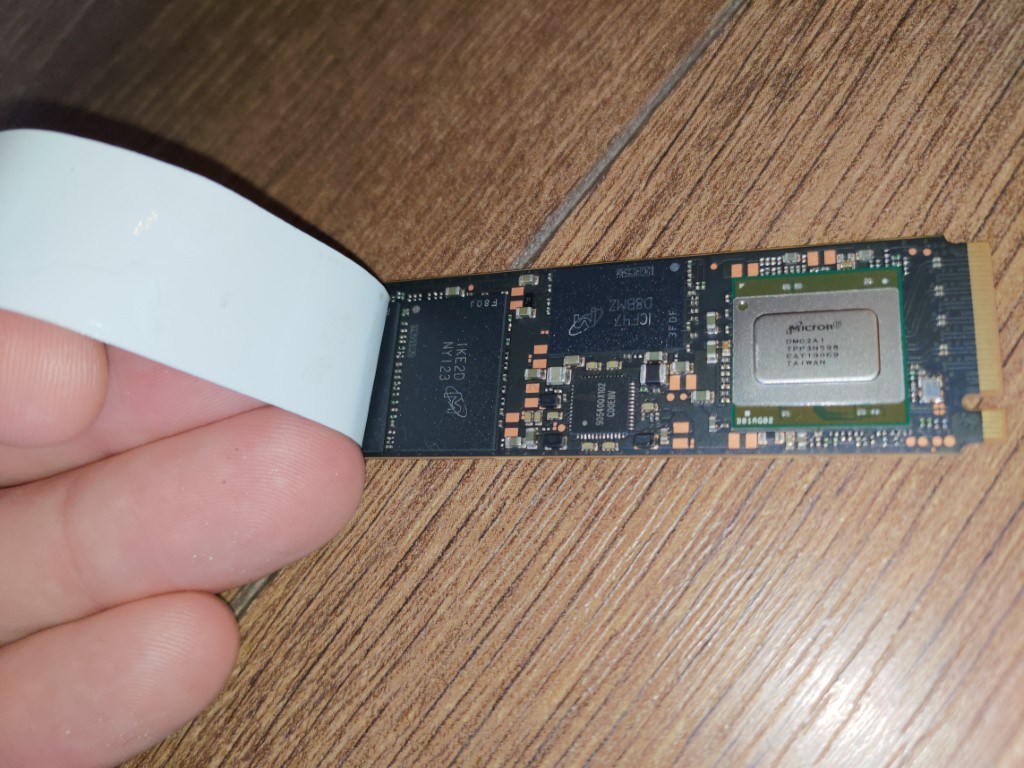
Much like the Controller on the Crucial P5 Plus being the ‘CPU’, it also has an area of memory. The Crucial P5 Plus SSD uses LPDDR4 memory on board and this in conjunction with the first party controller provides a massive body of data handling resources for getting your data moving through the SSD and out of the m.2 NVMe PCIe 4 interface. The amount of memory scales in conjunction with the 500GB, 1TB or 2TB SSD you use, with 2GB of DDR4 at the on the 2TB tier, 1GB DDR4 on the 1TB and 500GB models. As mentioned, all available capacities of the Crucial P5 Plus arrive at 2280 in length. This is quite normal for the 1TB and 2TB versions, but the fact that the 2TB can arrive on single-sided SSD boards is very impressive. Physical storage NAND is distributed evenly in order to space out the storage and allow even cooling, NAND wear and performance.
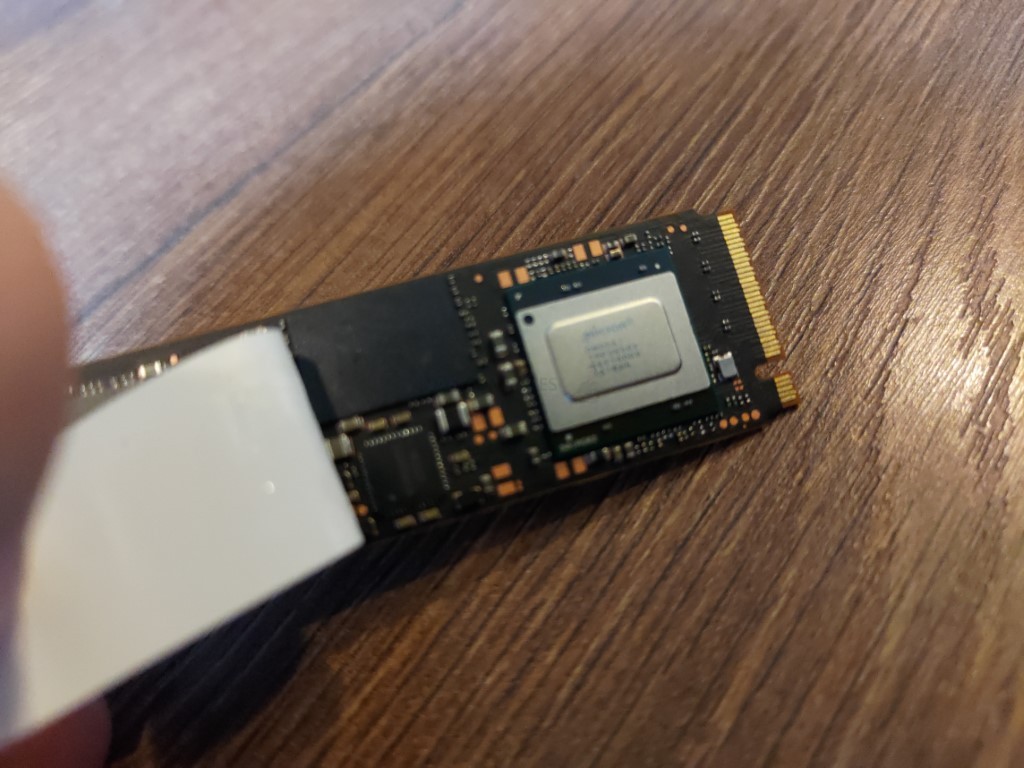
Finally, there is the M.2 NVMe connection. Not all m.2 SSDs are created equal and although M.2 SATA and M.2 NVMe look similar, they provide massively different performance and connectivity. However, the Crucial P5 Plus takes it one step further, by using a newer generation of PCIe Connectivity. In short, M.2 NVMe SSDs are connected to the host PC/Console system via PCIe protocol (think of those slots that you almost always use for your graphics cards, but a much, MUCH smaller connector). These allow much larger bandwidth (ie maximum speed) for the connected storage media, Much like regular PCIe slots, they have different versions (i.E PCIe Gen 1, 2, 3, 4, etc) and also a multiplying factor (x1, x2, x4, etc). Up until around 18 months ago, the best M.2 NVMes were M.2 PCIe Gen 3×4 (so a maximum 4,000MB/s possible). However, never generation SSD like the Crucial P5 Plus use PCIe Gen 4×4 (a potential 8,000MB/s possible) and it is only now that SSD controllers and NAND production has reached a point where it can catch up and fully saturate (i.e fill) this connection.
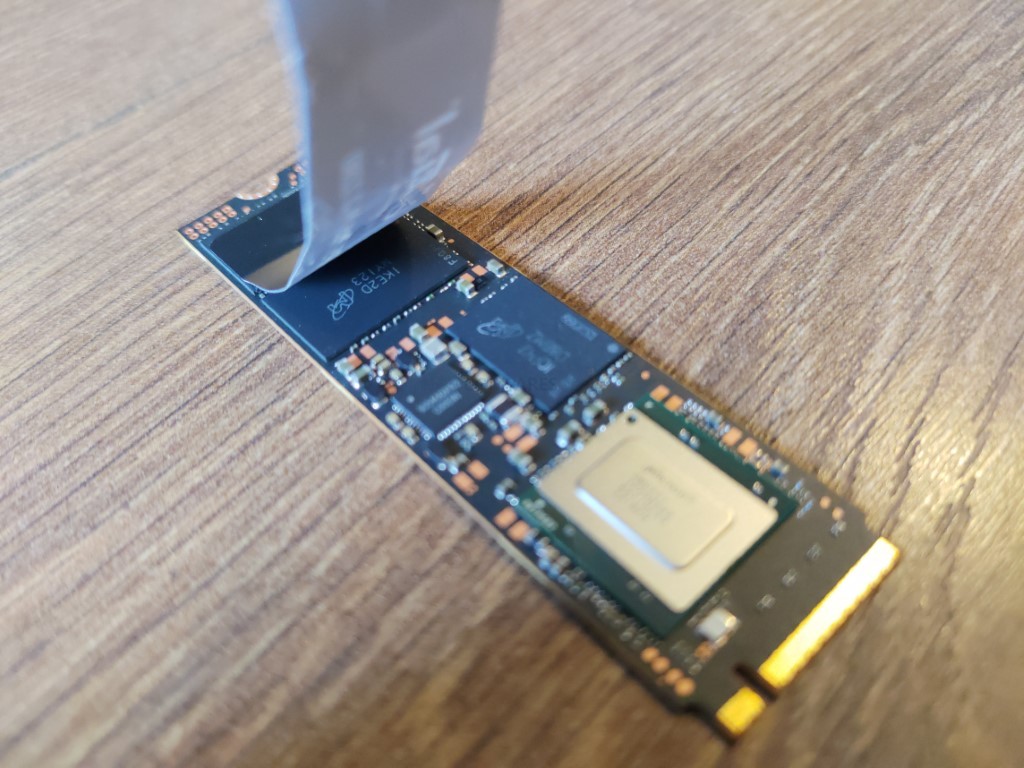
Overall, you really cannot fault the hardware inside/onboard the Crucial P5 Plus, as although the performance is not quite as high as other drives released in the last 4-6 months, it is arriving on the scene at a lower price point and one could argue these things scale. Before we go into the full testing, however, it is worth taking a moment to look closely at the reported performance benchmarks of the Crucial P5 Plus, as although the performance seems stellar, there are areas such as IOPS and endurance when compared with its main rivals that are worth taking into consideration.
Crucial P5 Plus SSD Review – Official Stats First
Before we conduct our own testing on this SSD, Let’s take a closer look at the reported specifications and benchmarks first. The Crucial P5 Plus SSD arrives in multiple capacities (below). The Prices currently are a little inconsistent (with each higher capacity tier actually having a higher price per GB – quite unusual) likely due to the hardware shortages, the Pandemic, Chia has affected SSD availability in the last 12 months and most recently the announcement that PS5 supports this SSD and it has increased the current price of both models around 10-20%!. Below is a breakdown of how each Crucial P5 Plus SSD compares:
| Brand/Series | CRUCIAL P5 PLUS
250GB – $64.99, 500GB – $104.99, 1TB – $179.99, 2TB – $364.99 |
Seagate Firecuda 530
500GB – $149.99, 1TB – $239.99, 2TB – $489.99, 4TB – $949.99 |
WD Black SN850
|
| PCIe Generation | PCIe Gen 4 | PCIe Gen 4 | PCIe Gen 4 |
| NVMe Rev | NVMe 1.4 | NVMe 1.4 | NVMe 1.4 |
| NAND | 3D TLC Micron 176L | 3D TLC Micron B47R 176L | BiCS4 96L TLC |
| Max Capacity | 2TB – Single Sided | 4TB – Double Sided | 2TB |
| Controller | Crucial NVMe Arch. | Phison E18-PS5018 | WD_BLACK G2 |
| Warranty | 5yr | 5yr | 5yr |
| 500GB Model | CRUCIAL P5+ 500GB | ZP500GM3A013 | WDS500G1X0E-00AFY0 |
| Price in $ and $ | $105 / £90 | $139 / £119 | $119 / £99 |
| 1TB Model | CRUCIAL P5+ 1000GB | ZP1000GM3A013 | WDS100T1X0E-00AFY0 |
| Price in $ and $ | $170 / £155 | $239 / £199 | $249 / £169 |
| 2TB Model | CRUCIAL P5+ 2000GB | ZP2000GM3A013 | WDS200T1X0E-00AFY0 |
| Price in $ and $ | $365 / £305 | $419 / £379 | $399 / £339 |
| 4TB Model | N/A | ZP4000GM3A013 | N/A |
| Price in $ and $ | N/A | $949 / £789 | N/A |
| 500GB Model | CRUCIAL P5+ 500GB | ZP500GM3A013 | WDS500G1X0E-00AFY0 |
| Total Terabytes Written (TBW) | 300TB | 640TB | 300TB |
| Mean Time Between Failures (MTBF, hours) | 2,000,000 | 1,800,000 | 1,750,000 |
| DWPD | 0.3DWPD | 0.7DWPD | 0.3DWPD |
| 1TB Model | CRUCIAL P5+ 1000GB | ZP1000GM3A013 | WDS100T1X0E-00AFY0 |
| Total Terabytes Written (TBW) | 600TB | 1275TB | 600TB |
| Mean Time Between Failures (MTBF, hours) | 2,000,000 | 1,800,000 | 1,750,000 |
| DWPD | 0.3DWPD | 0.7DWPD | 0.3DWPD |
| 2TB Model | CRUCIAL P5+ 2000GB | ZP2000GM3A013 | WDS200T1X0E-00AFY0 |
| Total Terabytes Written (TBW) | 1200TB | 2550TB | 1200TB |
| Mean Time Between Failures (MTBF, hours) | 2,000,000 | 1,800,000 | 1,750,000 |
| DWPD | 0.3DWPD | 0.7DWPD | 0.3DWPD |
| 4TB Model | N/A | ZP4000GM3A013 | N/A |
| Total Terabytes Written (TBW) | N/A | 5100TB | N/A |
| Mean Time Between Failures (MTBF, hours) | N/A | 1,800,000 | N/A |
| DWPD | N/A | 0.7DWPD | N/A |
There are clear throughput improvements as you rise through the capacity tiers (not unusual), as does the rated 4K IOPS. Though one area worth focusing on a little is that TBW (terabytes Written) and DWPD (Drive writes per day), as this drive is rated the same as the Samsung 980 Pro and WD Black SN850 in terms of NAND lifespan on daily writes, despite the NAND being considerably more layered. This is an important point because the brand has significantly less pedigree in content-creator and gaming SSD media circles than the likes of Samsung, WD and Seagate and people will want to know they are going to get a product that lasts!
However, despite the use of the high end in-house Crucial controller and 176 layer NAND, the reported IOPS on each capacity is actually a noticeable degree lower than those reported by their competitors. Indeed, the Crucial P5 Plus is one of the few premium-class brand offerings that does not cross into the reported 1 Million IOPS mark, maxing out at 700k. This is still very impressive anyway, but it does make me wonder where the disparity stems from. Indeed, when you look at the bulk of PCIe 4×4 M.2 NVMe 1.4 SSD, which feature the E18 Phison controller and 96L on board, it really only leaves about 6 other SSDs in the market today that this can be compared against. The WD, the Samsung, the Sabrent Rocket 4 Plus, the MSI Spatium M480, the ADATA Gammix S70 and (current leader) the Seagate Firecuda 530. Of those, almost all outpace the seq-read of the Crucial P5 PlusP5 Plus SSD, though things are a little better on Sequential Write in the smaller tiers. Most users will likely be considering the currently trending WD Black to Seagate Firecuda drive, so let’s take a look and see how the Crucial P5 Plus compares against them:
| Brand/Series | CRUCIAL P5 PLUS
250GB – $64.99, 500GB – $104.99, 1TB – $179.99, 2TB – $364.99 |
Seagate Firecuda 530
500GB – $149.99, 1TB – $239.99, 2TB – $489.99, 4TB – $949.99 |
WD Black SN850
|
| 500GB Model | CRUCIAL P5+ 500GB | ZP500GM3A013 | WDS500G1X0E-00AFY0 |
| Sequential Read (Max, MB/s), 128 KB | 6600MB | 7000MB | 7000MB |
| Sequential Write (Max, MB/s), 128 KB | 4000MB | 3000MB | 4100MB |
| 1TB Model | CRUCIAL P5+ 1000GB | ZP1000GM3A013 | WDS100T1X0E-00AFY0 |
| Sequential Read (Max, MB/s), 128 KB | 6600MB | 7300MB | 7000MB |
| Sequential Write (Max, MB/s), 128 KB | 5000MB | 6000MB | 5300MB |
| 2TB Model | CRUCIAL P5+ 2000GB | ZP2000GM3A013 | WDS200T1X0E-00AFY0 |
| Sequential Read (Max, MB/s), 128 KB | 6600MB | 7300MB | 7000MB |
| Sequential Write (Max, MB/s), 128 KB | 5000MB | 6900MB | 5100MB |
| 4TB Model | N/A | ZP4000GM3A013 | |
| Sequential Read (Max, MB/s), 128 KB | N/A | 7300MB | N/A |
| Sequential Write (Max, MB/s), 128 KB | N/A | 6900MB | N/A |
| Brand/Series | CRUCIAL P5 PLUS | Seagate Firecuda 530 | WD Black SN850 |
| 500GB Model | CRUCIAL P5+ 500GB | ZP500GM3A013 | WDS500G1X0E-00AFY0 |
| Random Read (Max, IOPS), 4 KB QD32 | 360,000 | 400,000 | 1,000,000 |
| Random Write (Max, IOPS), 4 KB QD32 | 700,000 | 700,000 | 680,000 |
| 1TB Model | CRUCIAL P5+ 1000GB | ZP1000GM3A013 | WDS100T1X0E-00AFY0 |
| Random Read (Max, IOPS), 4 KB QD32 | 630000 | 800000 | 1,000,000 |
| Random Write (Max, IOPS), 4 KB QD32 | 700000 | 1000000 | 720,000 |
| 2TB Model | CRUCIAL P5+ 2000GB | ZP2000GM3A013 | WDS200T1X0E-00AFY0 |
| Random Read (Max, IOPS), 4 KB QD32 | 720,000 | 1,000,000 | 1,000,000 |
| Random Write (Max, IOPS), 4 KB QD32 | 700,000 | 1,000,000 | 710,000 |
| 4TB Model | N/A | ZP4000GM3A013 | |
| Random Read (Max, IOPS), 4 KB QD32 | N/A | 1,000,000 | N/A |
| Random Write (Max, IOPS), 4 KB QD32 | N/A | 1,000,000 | N/A |
Yes, that is a LONG table, but you can immediately see that the Seagate Firecuda 530 raises the stakes on all of the key specifications. Although there are a number of micro reasons for this, the 176L NAND is the biggest factor here which already put it ahead of the WD/Samsung previously. But of course, that is why the Firecuda 530 commands the higher price tag. Additionally, the WD Black arriving at a better price point, higher IOPS in most tiers and the fact it does this whilst still hitting that 7,000MB/s certainly gives pause for thought. However, for many, the additional cost for higher durability they may never need, peak performance their core system will not reach and IOPS rating that their larger file handling will never utilize will mean that holding out for the Firecuda or WD Black SN850 is not in their interest. Both SSDs (on paper at this stage!) are fantastic examples of where consumer and prosumer SSDs are evolving towards. The Crucial P5 Plus SSD on the other hand gets quite close to both of these SSDs in these key specs and does it at clearly lower price per TB on every single capacity tier, which will definitely appeal to users who are already on the edge of their budget. Let’s get the Crucial P5 Plus on the test machine!
Testing the Crucial P5 Plus m.2 PCIE4 NVMe SSD
The Crucial P5 Plus was selected for this test and it was tested using multiple benchmark tools, from a cold boot, in the 2nd storage slot (i.e not the OS drive). Each test was conducted three times (full details of this are shown in the YouTube Review of the Crucial P5 Plus over on NASCompares):
Test Machine:
- Windows 10 Pro Desktop System
- Intel i5 11400 Rocket Lake – 6-Core 2.6/4.4Ghz
- 16GB DDR4 2666MHz Memory
- Intel B560M mATX Motherboard
- OS Storage, Seagate Firecuda 120 SSD
- Test SSD connected to Secondary PCIe Gen 4 M.2 Slot
Using CrystalDisk, we got a good measure of the drive and verified that this PCIe Gen 4 x4 SSD was indeed using the 4×4 lane. Additionally, the temp averaged out around 41C between each test being conducted.
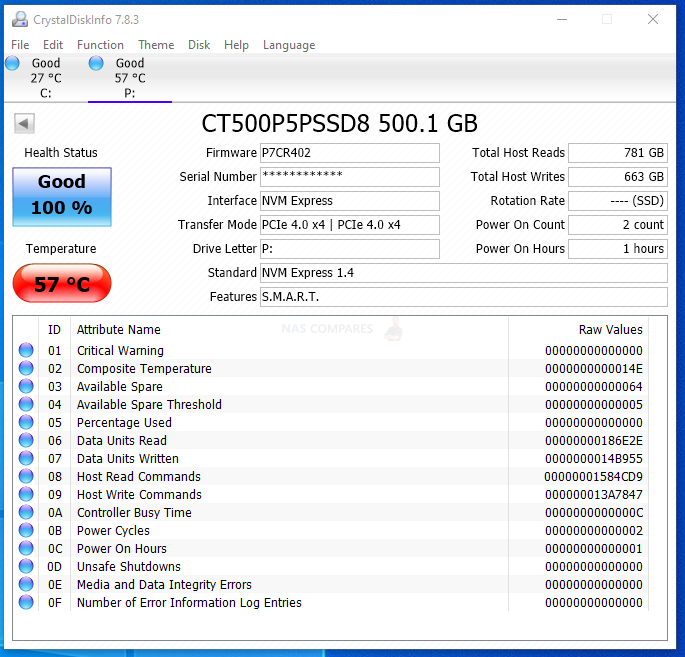
The first tests were conducted using the ATTO disk benchmark software. The first was a 256MB test file size and below is a breakdown of the transfer rates and IOPS. The 2nd Test was a 1GB test file and finally, the last test was with a 4GB test file. The system was given 1-minute cool downtime between tests, no screen recording software was used (remove overhead) and a heatsink was used throughout (no reboots)
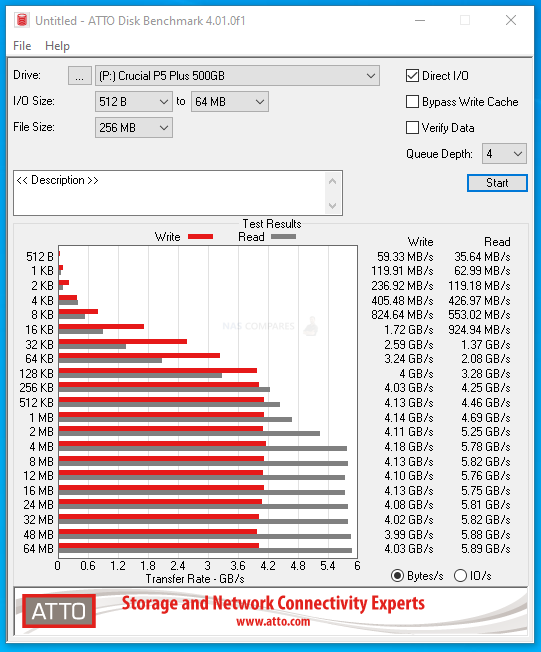 |
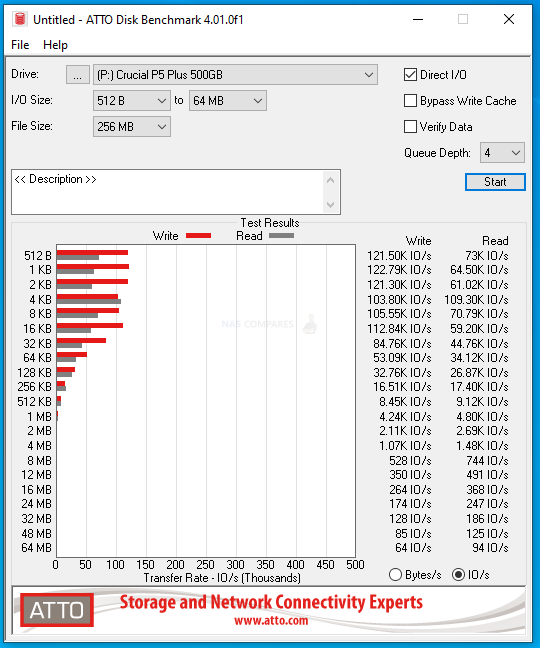 |
ATTO Disk Benchmark Test #1
256MB File PEAK Read Throughput = 5.89GB/s
256MB File PEAK Write Throughput = 4.18GB/s
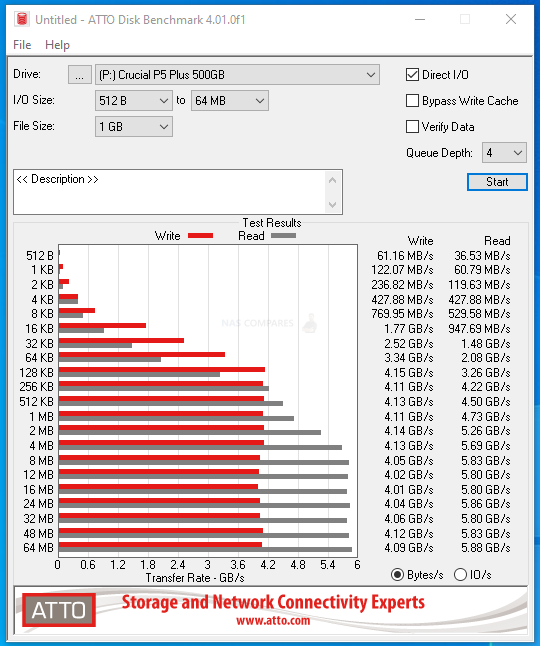 |
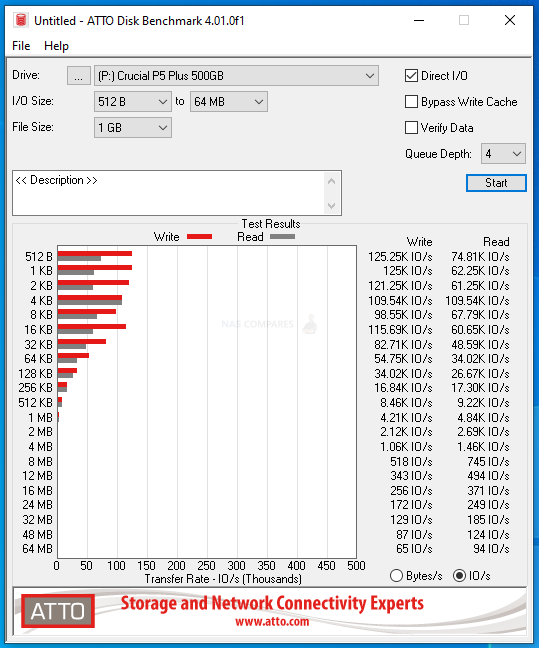 |
ATTO Disk Benchmark Test #2
1GB File PEAK Read Throughput = 5.88GB/s
1GB File PEAK Write Throughput = 4.15GB/s
 |
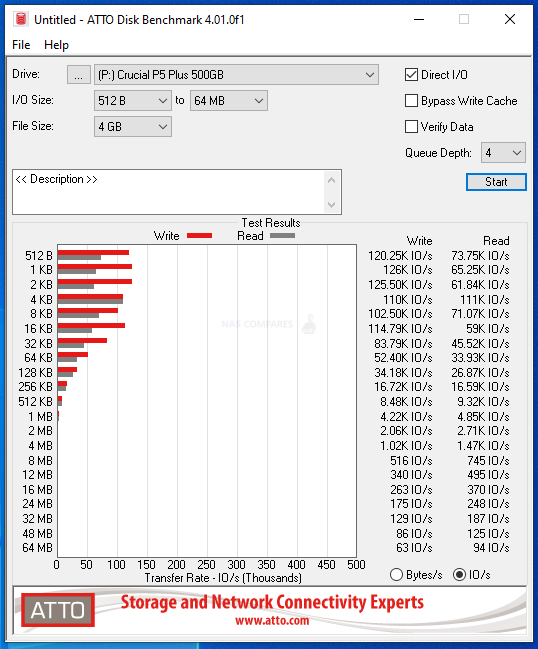 |
ATTO Disk Benchmark Test #3
4GB File PEAK Read Throughput = 5.90GB/s
4GB File PEAK Write Throughput = 4.17GB/s
Next, although the ATTO tests were quite good, but not what I would have hoped from this SSD, so I moved on to the Crystal Disk Mark testing to see how well it would handle our lasts barrage of tests. The first test was the 1GB file testing, which measured both sequential and random, as well as the read and write IOPS. Test were conducted on a 1GB, 4GB and 16GB Test File. I also included a mixed 70/30 read and write task to give a little bit more of a realistic balanced workload. These tests were conducted with 1-minute cooling break in between
CRYSTALDISK MARK 1GB TEST
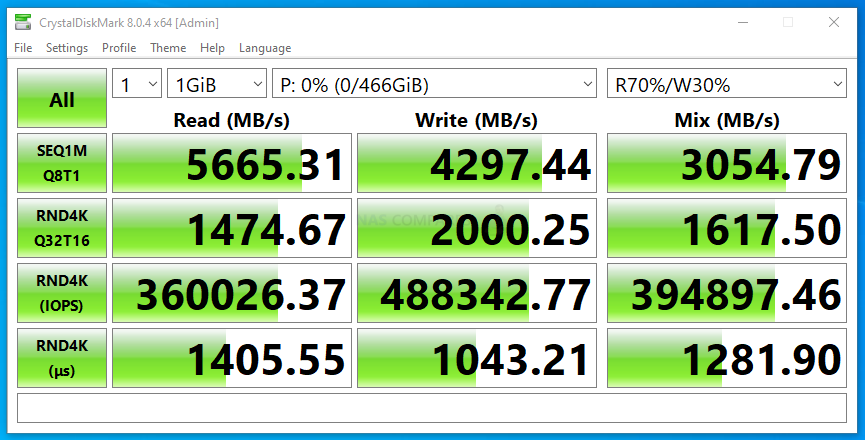
CRYSTALDISK MARK 4GB TEST
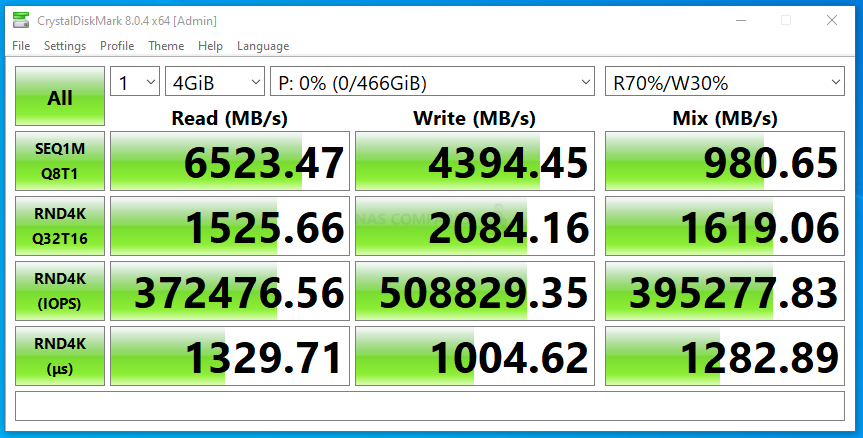
CRYSTALDISK MARK 16GB TEST
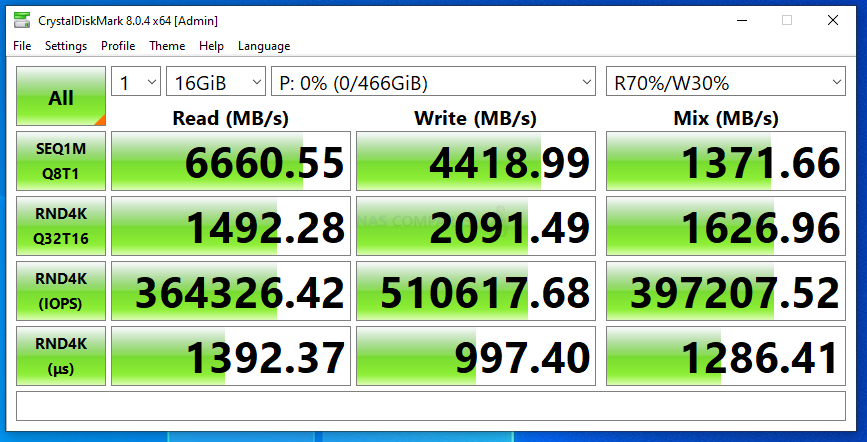
Next, I switched to AS SSD benchmark. A much more thorough test through, I used 1GB, 3GB and 5GB test files. Each test includes throughput benchmarks and IOPS that are respective to the larger file sizes (important, if you are reading this and trying to compare against the reported 4K IOPS from the manufacturer).
AS SSD Benchmark Test #1
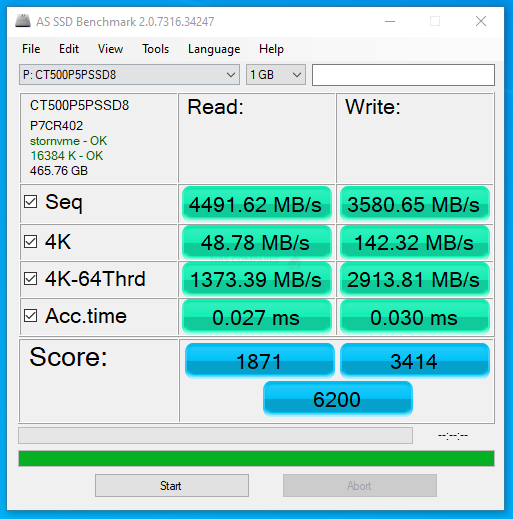 |
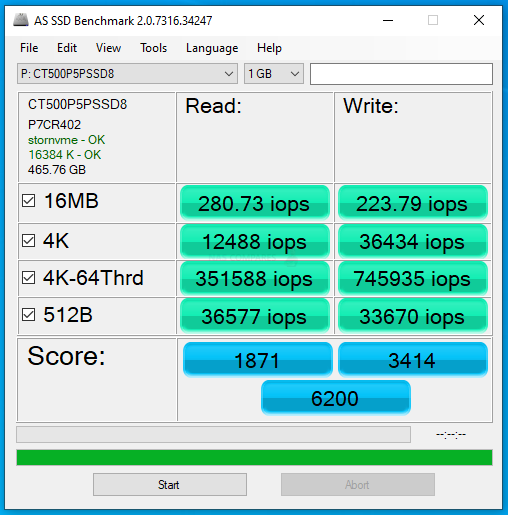 |
AS SSD Benchmark Test #2
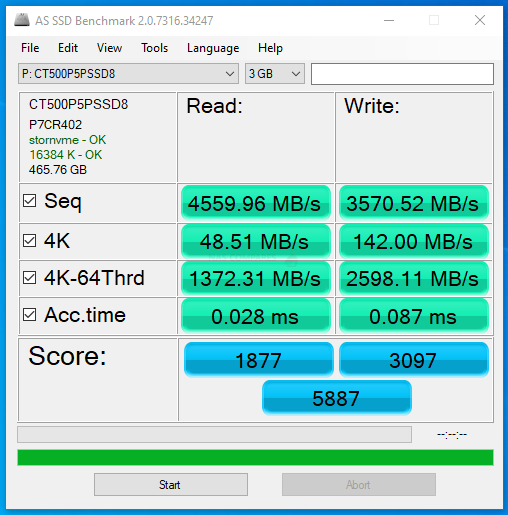 |
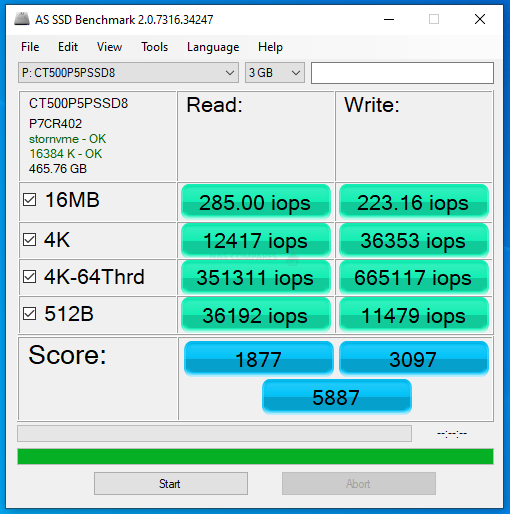 |
AS SSD Benchmark Test #3
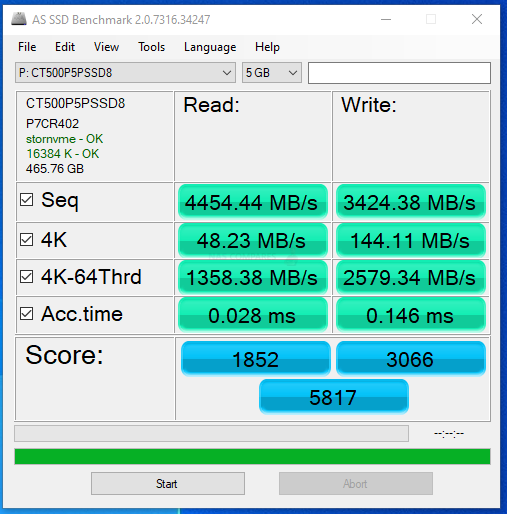 |
 |
Ordinarily, I would introduce tests like BlackMagic and AJA into the mix here, but even a short burst of testing on an NVMe like this would over saturate the cache memory on board. Nevertheless, in the short term we still could ascertain the reported performance on 1GB, 4GB and 16GB file testing was:
1GB AJA File Test Results (Peak) = 5438MB/s Read & 4935MB/s Write

4GB AJA File Test Results (Peak) = 5422MB/s Read & 4940MB/s Write

16GB AJA File Test Results (Peak) = 5389MB/s Read & 4912MB/s Write

Overall, the Crucial P5 Plus was certainly able to provide some solid performance, as well as potentially exceed the test figures here on a more powerful machine. Given the reported Read and Write statistics that the brand has stated publically, I think there is enough evidence here to back up those claims. IOPs were a little lower than I expected, but again, we were testing very large file types, so this would have to be taken in context.
Crucial P5 Plus SSD Review – Conclusion
The Crucial P5 Plus is an SSD that has arrived into the market alongside a bunch of other PCIe 4.0 NVMe SSDs, but does it via another door. Much like how the Seagate Firecuda 530 arrived with a primary focus on Durability and Endurance for their drive, the Crucial P5 Plus arrives with some of the most mature and affordable architecture available in this new wave of storage. Rather than target the obvious and potentially un-relatable high sequential read/write audience, that may find out shortly afterwards that this isn’t typical of day-to-day use, Crucial have produced a much more multi-purpose drive that wants to appeal to more users. It would be foolish to ignore that the price point of the P5+ is not one of its most appealing factors for some, but this is further improved by the fact that this is an almost exclusively in-house drive, which is increasingly rare right now. Where the Critical P5 Plus SSD falters is when you make direct comparisons against other PCIe4 drives on sustained big-data performance and when you look more closely at its power efficiency. If you are considering the Crucial P5 for your PC or PS5 gaming storage setup, there are better drives out there right now. But for general use, caching of smaller data, as well as for business buyers looking for a good balance of performance vs reliability vs price, this is likely your best choice for this evolving SSD type.
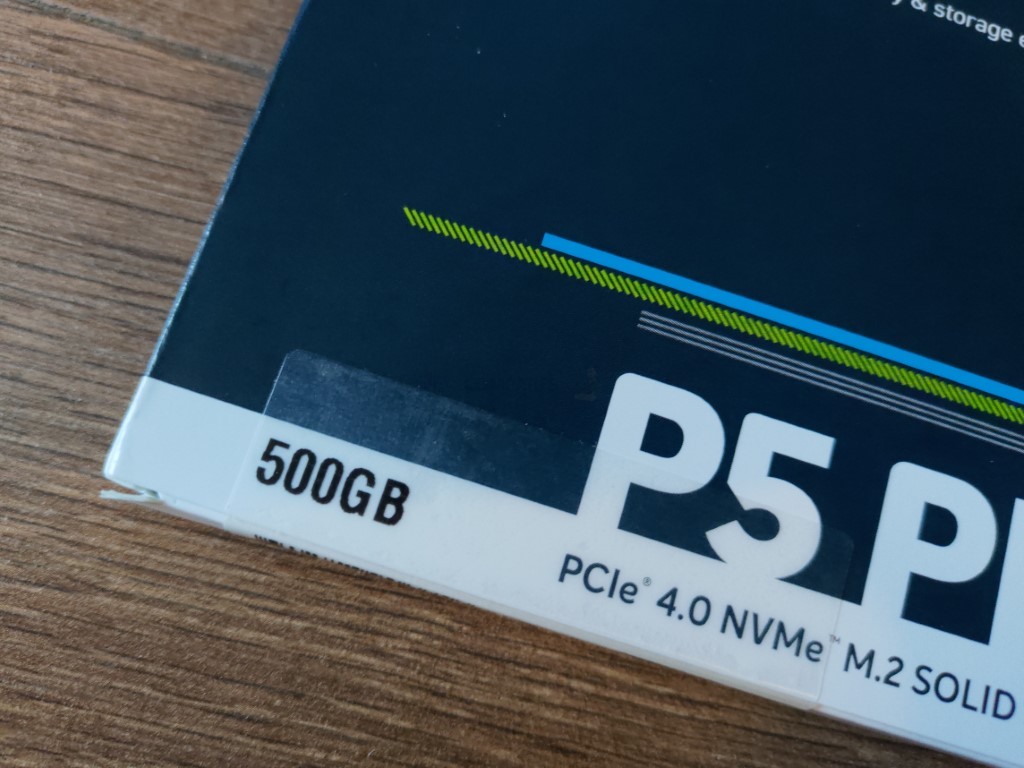
| PROs of the Crucial P5 Plus | CONs of the Crucial P5 Plus |
| Good Price vs Capacity Across the range
PS5 Compatibility Confirmed Hardware Encryption on-board (256bit) Consistent Read/Write Reported on each capacity model Endurance comparable to Samsung & WD Alternatives 250GB Model for Budget/Small Buyers Available |
Controller Compares a little worse than the Phison E18 from competitors
Ran hot in testing Lesser endurance than Seagate, Corsair & Sabrent Alternatives |
🔒 Join Inner Circle
Get an alert every time something gets added to this specific article!
This description contains links to Amazon. These links will take you to some of the products mentioned in today's content. As an Amazon Associate, I earn from qualifying purchases. Visit the NASCompares Deal Finder to find the best place to buy this device in your region, based on Service, Support and Reputation - Just Search for your NAS Drive in the Box Below
Need Advice on Data Storage from an Expert?
Finally, for free advice about your setup, just leave a message in the comments below here at NASCompares.com and we will get back to you. Need Help?
Where possible (and where appropriate) please provide as much information about your requirements, as then I can arrange the best answer and solution to your needs. Do not worry about your e-mail address being required, it will NOT be used in a mailing list and will NOT be used in any way other than to respond to your enquiry.
Need Help?
Where possible (and where appropriate) please provide as much information about your requirements, as then I can arrange the best answer and solution to your needs. Do not worry about your e-mail address being required, it will NOT be used in a mailing list and will NOT be used in any way other than to respond to your enquiry.

|
 |
The Best Bits (and Worst Bits) of NAS of 2025!
Minisforum MS-02 Ultra Review
Minisforum N5 NAS, 6 Months Later - Better, Worse, the Same?
Beelink ME Pro NAS Revealed
Best SOLID STORAGE NAS of 2025
Should You Worry About the NanoKVM Hidden Microphone?
Access content via Patreon or KO-FI





Discover more from NAS Compares
Subscribe to get the latest posts sent to your email.


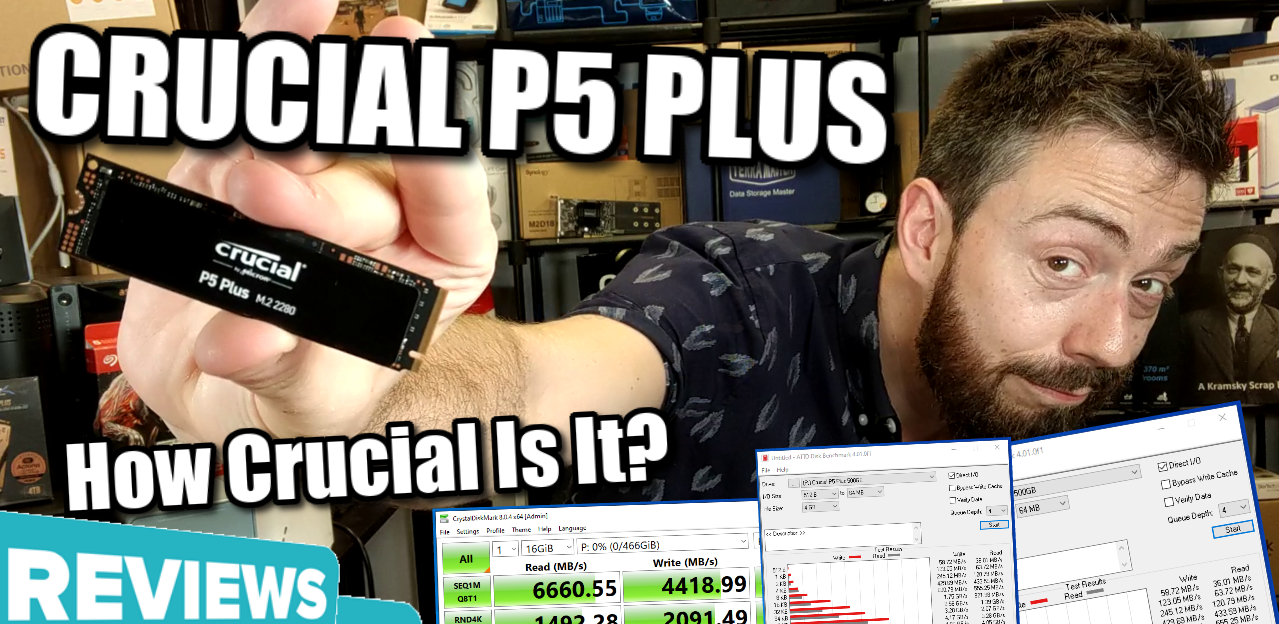







A really good & detailed video ????
REPLY ON YOUTUBE
Very (very) detailed testing.
Well done!
I am going to install a 500 GB, P5 Plus in my Aspire 5, (i-5). May have to use a copper heat shield if the temps are all that high. (There is precious little space in there.) Wish me luck.
Cheers!
REPLY ON YOUTUBE
I dont know what the comparisons were at the end cos you didnt actually say.
REPLY ON YOUTUBE
I just checked my 1 TB P5 Plus. Read: 8031.85 Write: 6958.15.
REPLY ON YOUTUBE
Your voice sound like Ali G ????
REPLY ON YOUTUBE
I got the 1TB for $38
steal deal, more so since I’m only running it on a Gen3 platform (4GB/s)
REPLY ON YOUTUBE
wow cool im wondering why my P5 plus not showing those test?? its under 3700 for me
REPLY ON YOUTUBE
brother i bought this p5 plus today.
its working and showing up fine.
i even installed its driver from the websites but it’s not showing up in device manager detail that its storage control is by micron ????????
its driver installation went absolutely fine but still isnt showing up rather showing the standard Microsoft driver ????????????. please help what is going on with me
REPLY ON YOUTUBE
Another idea I had that my brother changed my mind about. For external storage on PS5, I assumed a standard external hdd would be just fine. However, my brother who is more technically inclined then myself, he says I should consider using a 2.5 hdd like we use in in a laptop? With a external 2.5 hdd case so it can plug in to the ps5 with usb. My brother says the external hdd are very finicky and easy to damage. Just that the 2.5 hdd is the best option is what he says, is that true?
REPLY ON YOUTUBE
Can I use this in my sons PS5?
After watching your videos, I grabbed the WD black 4tb with the Elecgear heatsink for my personal PS5. Thanks for al the detailed reviews! You’re by far the best at doing this. The extreme details and tests you do have been the game changer we’ve been in need of! You rock dude! ????lol
REPLY ON YOUTUBE
Excellent video!…..Subbed.
REPLY ON YOUTUBE
It is normal that my Crucial p5 have in load about 70 Celsius? Thanks
REPLY ON YOUTUBE
I don’t get why are people so afraid about these temperatures? It is perfectly fine for the controller and flash chips operate better at this temperature, you are actually lowering their performance a durability when cooling them too much. Quick temperature changes are the worst you can do for flash chips. The only thing that might need cooling is the controller.
REPLY ON YOUTUBE
Just got this P5 plus 2TB for $149
REPLY ON YOUTUBE
So much cheaper buy directly from crucial, especially here in Malta where amazon charges about 20 euro shipping on even small items like this and forget about retailers here, add about 30 percent on pretty much every computer component. Not only free shipping from crucial, only 9e for tracking and 3 day delivery. Wish all manufacturers cut out the middle man and sold and shipped direct.,
REPLY ON YOUTUBE
Love the videos, but the sound output is really low, i have to crank volume way up, compared to day to day other things and other youtube channels
REPLY ON YOUTUBE
Good job as always. I like your movies.
Could you (or anyone) recommend some SSD m.2 gen4 x 4 drive that has electronics (memory, controller, etc.) on one side of the board (laminate)?
I need these for the Asus G14, because the Kingston KC3000 2 TB SSD has memory on both sides. The lower memories (the ones from below) are in contact with the wi-fi/bluettotch card 🙁
Sorry for my english.
REPLY ON YOUTUBE
been looking at that product and funny enough the 2 terabyte m.2 is 207$ while the 1 terabyte is 160$. for that price I take the 2tb one.
REPLY ON YOUTUBE
I got it for 66.27 pounds to death, lightning deal, I also got their 8gb bloody you kit stick for 23 pounds to death. I didn’t know it was that absurd world wide quenched.
REPLY ON YOUTUBE
Have mine. Installed and love it.
REPLY ON YOUTUBE
Would this work for recording 4K video from a camera like SIGMA fp or with an Atomos Ninja V?
REPLY ON YOUTUBE
thanks! good review. You are very competent in storage. I am ordering the p5 plus 1tb and a AORUS Gen4 SSD 1TB (GP-AG41TB) with a insane 1800TBW
REPLY ON YOUTUBE
Damn that’s deep testing. Nice video, I like it, will check more videos from your channel
REPLY ON YOUTUBE
This is going for a great price in the UK, 2TB model can be had for £171
REPLY ON YOUTUBE
Most of the head scratchers you have are because if you do a tad of homework
the P5 model is for, you guessed it, the PS5.
Sure it will work on any nVME supporting system, but its features were made for console.
REPLY ON YOUTUBE
The 1tb ones are darn cheap from Scorptec in aus, I grabbed one for my OS drive and user files storage.
REPLY ON YOUTUBE
6000 – 7000 makes zero difference if you are gaming.
Hell a 570 blue would be a better buy for gaming.
Saying that these are coming up for sale at £69 for the 500GB which is a tempting price.
REPLY ON YOUTUBE
so what yours suggestion for legion 5 pro?
REPLY ON YOUTUBE
looks in the description. sponsored by crucial.
REPLY ON YOUTUBE
Great information ????
I hope the 2TB version works as well. I bought a new never used (but no box) with heatsink for £199 … Should have it mid week.
REPLY ON YOUTUBE
I don’t know about prices in the UK, but right now firecuda goes around 120 quid, while Crucial sits firmly at 75 quid. I triple checked and the firecuda is 500gb. You can get 1TB Crucial and it still would be cheaper…
REPLY ON YOUTUBE
My p5 plus is averaging 3000mbps not 6000mbps what is going on
REPLY ON YOUTUBE
my gtx 1060 is ready
REPLY ON YOUTUBE
Okay, so I just received mine, but when I do a speed test the read is only about 2400 mb/s. Why isn’t it around 5-6k?
REPLY ON YOUTUBE
My main kick point for Crucial and Micron is that they are both American based companies. So I love supporting them. High quality American made. First gen AMD Ryzen had issues with Samsung NVME drives. Second gen solved the issue but still. Meanwhile Crucial had no issues day one. And moving forward I see Crucial and Micron beating Korean and Chinese brands.
REPLY ON YOUTUBE
So I have a msi gf65 thin 10SDR should I get the crucial P5 plus or just the crucial P5? Cause this laptop is only gen3 I guess but I want the most latest SSD this being the P5 plus but would I get less performance than the regular P5 or should I go ahead and get the P5 plus?
REPLY ON YOUTUBE
I wouldn’t buy this one until the price drops significantly. for 4.0, you can get better options at a cheaper price. for example: the WD 850 is on sale at cheaper prices.
REPLY ON YOUTUBE
I just did a test to see if the Precision 5550 had PCIe Gen 4.0 and it does not. However, I got 3400MB read and 3200MB write and the #’s the rest of the way were pretty solid and close to each other. The last two write tests were faster than the read. Overall nice drive. This after me cloning a 500GB to 1TB and the data cloned was 80GB. Took 4min 30 sec.
REPLY ON YOUTUBE
I do have one for sale for any interésting
REPLY ON YOUTUBE
The PNY 3140 2TB installed in my PS5 – with a heatsink ofc. It’s being nothing but brilliant. Tests with 1TB & below are not that interesting.
REPLY ON YOUTUBE
Crucial P5 Plus or WD SN850?
REPLY ON YOUTUBE
Just to let everyone know, seating your SSD make take multiple attempts to get it installed proper. It took me 4 try’s before my PS5
recognized the M.2 drive.
REPLY ON YOUTUBE
Finally got my fire cuda 530 4tb with heat sink. Can’t wait for the ps5 to be able to use it. I really need the extra space. ????
REPLY ON YOUTUBE
Anotjer great video! Quick question: Is it still available only for BETA users? My PS5 doesn’t let me add anything just yet… ????
REPLY ON YOUTUBE
The Seagulls were being considerate for once. ????
REPLY ON YOUTUBE
How useful do you think are the power loss protection and RAIN features that some Crucial drives have? Reviewers don’t seem to mention them much.
REPLY ON YOUTUBE
You should do a Synology vs QNAP video
REPLY ON YOUTUBE
Always excellent video
REPLY ON YOUTUBE